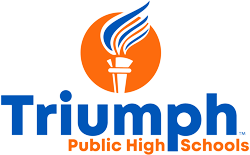Curriculum, Instruction & Assessment
Our goal is to ensure that we provide vision, leadership and expertise in the development of curricular and instructional systems and programs that are research based, student-centered and address the standards outlines in the Texas Essential Knowledge and Skills (TEKS), College and Career Readiness Standards (CCRS) and English Language Proficiency standards (ELPS).
Staff Contact

Gautier Tirado
Corporate Instructional Officer
Gautier.Tirado@triumphpublicschools.org
731 Fredericksburg Road
San Antonio, TX 78201
Office (210) 227-0295
Fax (210)-227-7879
- El Paso ISD Career and Technical Education (CTE) 2022-2023 SY [El Paso]
- El Paso County Community College District 2021-2022, 2022-2023 & 2023-2024 SYs [El Paso]
- Howard Payne University –Dual Credit 2022-2023 [El Paso]
- McMurry Dual Credit Academy –Dual Credit [El Paso]
- Laredo College and Texas A&M International University – College Prep Mathematics & English [Laredo]
- McMurry Dual Credit Academy – Dual Credit [Laredo]
- South Texas Training MOU for 2023-2024 SY [Laredo]
- McMurry Dual Credit Academy – Dual Credit [Lubbock]
- South Plains College – College Preparatory Mathematics and ELA Course [Lubbock]
- South Plains College – Dual Credit Partnership [Lubbock]
- McMurry Dual Credit Academy – Dual Credit [Rio Grande Valley]
- Rio Grande Valley Institutions of Higher Education RGV IHEs – College Prep Mathematics & English [Rio Grande Valley]
- South Texas College – Dual Credit 2022-2023 SY [Rio Grande Valley]
- South Texas Training MOU for 2023-2024 SY [Rio Grande Valley]
- ESF Overview
- ESF Booklet
- ESF Theory of Action
- Lever 1: Strong School Leadership and Planning
- Lever 2: Strategic Staffing
- Lever 3: Positive School Culture
- Lever 4: High-Quality Instructional Materials and Assessments
- Lever 5: Effective Instruction
- Texas ESF Website
- Odell Texas High School Literacy Program
TRIUMPH PUBLIC HIGH SCHOOL, INC.
dba, Triumph Public High Schools (El Paso) CDN 071803
dba, Triumph Public High Schools (Laredo) CD 240801
dba, Triumph Public High Schools (Laredo) CD 240801
dba, Triumph Public High Schools (Rio Grande Valley) CD 108804
2019-2020 School Year and Thereafter
Board Approved on
July 27, 2019
The purpose of the Triumph Public High Schools Grading guidelines is to provide students, parents and staff with a resource that establishes fairness and equity in grading as follows:
As per grading policy, including provisions for the assignment of grades on class assignments and examinations, before each school year. The Charter District grading policy is delineated as follows:
- Requires a classroom teacher to assign a grade that reflects the student’s relative mastery of an assignment;
- Prohibits classroom teacher to assign a minimum grade for an assignment without regard to the student’s quality of work; and
- Allows a student a reasonable opportunity to make up or redo a class assignment or examination for which the student received a failing grade.
Attendance
It is important to note that poor attendance adversely affects grades. To receive credit or a final grade in a class, a student in must attend at least 90 percent of the days the class is offered. By failing to meet state minimum standards for days in class, students lose credit for the class even if a passing grade is earned. Please refer to the student handbook for additional information.
Finality of a Grade
Although improperly recorded grades may be challenged, contesting a student’s grade in a course or on an examination is handled through the general complaint process found in the student handbook. A grade issued by a classroom teacher can be changed only if, as determined by the board of trustees, the grade is arbitrary, erroneous, or inconsistent with the charter’s grading policy.
Grade Averaging
Starting with the 2015-2016 school year, half credits for a two-semester course may not be earned. Cycle grades for one credit courses will be averaged and full credit will be earned at the end of the course, no partial credit will be assigned.
- By way of explanation, partial credit will not be given if the student passes only one portion of a one credit course. On the failed portion, a student with a grade of 65 – 69 has 10 school days immediately after the end of the nine-week period to make up the work with the teacher and achieve a passing grade for the failed portion. If the student fails to make a passing grade within the 10 days, at the end of the semester the student may have to retake the full class again. The Principal has the discretion to schedule the student or having him/her take the course through self-paced, on-line courses, summer school, etc.
A final passing grade will be awarded if the average of both semesters is at least 70%. For courses taken through a self-paced program to include the American Preparatory Institute (API) program a final passing grade will be awarded if the average of both semesters is at least 80%.
Final grades will be determined using the following method of averaging grades,
- 50% for daily work,
- 35% quizzes and tests, and
- 15% for final exam.
For More information regarding grading please refer to the student handbook: Section 3: Academics and Grading.
Charter Division Revised Grading Guidelines – Board Approval July 27, 2019 – Download PDF
- PGP Setup Step 1
- PGP Steup Step 2
- TxEIS PGP Step by Step Instructions
- TxEIS PGP Data Tables
- How to Build a Student Graduation Plan & PGP
- Quick Guide to Creating Graduation Plans
- Quick Guide to Assigning Graduation Plan (Group)
- Quick Guide to Assigning Graduation Plan (Individual)
- Quick Guide to Assigning Plans Manually
- Quick Guide to Assigning & Printing Personal Graduation Plans (PGP)
- Quick Guide to Reviewing the Graduation Plan
- Quick Guide to PGP Reports
What are Professional Learning Communities?
A Professional Learning Community is an ongoing process used to establish a schoolwide culture that develops teacher leadership explicitly focused on student learning and a commitment to improvement.
Teachers share experiences, observe each other, discuss teaching, and use collective inquiry to help sustain improvement. In addition, administrators share decision making with teachers, and provide opportunities for teachers to serve as leaders (The Center for Comprehensive School Reform and Improvement, 2009).
Professional Learning Communities have the following defining elements:
Focus on Learning – promote a shared vision dedicated to student learning and committed to school improvement (Reichstetter, 2006);
Build a Collaborative Culture – operate on the premise that teamwork allows professionals to achieve more than they can alone (DuFour & Eaker, 1998); and
Focus on Results – encourage teachers to respond to data with collective accountability and adjust classroom practices to improve student learning (White & McIntosh, 2007).
Resources
- A Facilitator’s Guide to Professional Learning Teams
- All Things PLC
- Finding Time for Collaboration
- Finding Time for Common Planning and/or Teacher Collaboration
- SEDL: First Steps
- PLC: A Brief Guide
Videos
- Establishing a Core Team
- Campus Culture and Climate
- What makes great teachers or school leaders?
- Opening The Black Box for Quality Implementation
Tools/Activities
Annual Notification of Nondiscrimination in Career and Technical Education Programs
August 23, 2023
SUBJECT: Required Annual Notification of Nondiscrimination in Career and Technical Education Programs
The Office for Civil Rights (OCR) of the United States Department of Education requires that districts, including charter schools, provide career and technical education (CTE) programs, services, and activities in accordance with the requirements of Title VI of the Civil Rights Act of 1964, Title IX of the Education Amendments of 1972, Section 504 of the Rehabilitation Act of 1973, and Title II of the Americans with Disabilities Act of 1990. The Texas Education Agency (TEA) has regulatory responsibilities for CTE programs in Texas public secondary schools and is required to adopt a civil rights compliance program to identify, remedy, and/or prevent discrimination in the CTE programs operated by districts.
Requirements for compliance are found in the document, Guidelines for Eliminating Discrimination and Denial of Services on the Basis of Race, Color, National Origin, Sex, and Handicap in Vocational Education Programs (Guidelines). A link to the full text can be found at the CTE Methods of Administration (MOA) webpage, which is located on the School Improvement website at: https://tea.texas.gov/si/MOA/.
One important requirement of the Guidelines is that, prior to the beginning of each school year, every district providing CTE programs must advise students, parents, employees, and the public that all career and technical education opportunities will be offered without regard to race, color, national origin, sex, or disability. Local newspapers, websites, or other media that reach the public may be utilized to disseminate the required notification. Information regarding this requirement can be found in Section IV – O of the Guidelines under Public Notification.
An English and Spanish version of a sample public notification form, which includes all required elements for complying with this requirement, may be downloaded from the Methods of Administration (MOA) Guidance and Resources webpage at: https://tea.texas.gov/si/MOA/. Please note, the Guidelines state that if the district “contains a community of national minority persons with limited English language skills, public notification materials must be disseminated to that community in its language and must state that the district will take steps to assure that the lack of English language skills will not be a barrier to admission and participation in vocational education programs.” Therefore, if your district contains communities who speak languages other than English or Spanish, it also will be necessary for the district to prepare and disseminate the required notice in those languages.
Then if we could have the following titles and “links” to PDFs:
- 2022-2023 TPHS Approved Course Listing
- 2020-2021 TPHS Approved Course Listing
- 2016-2017 TPHS Approved Courses List PEIMS Data Standards **Requests to Add Courses Must be Submitted to the Superintendent **
- 2021-2022 TPHS El Paso East TIP
- 2022-2022 TPHS El Paso West TIP
- 2022-2022 TPHS Laredo North TIP
- 2022-2022 TPHS Laredo South TIP
- 2022-2022 TPHS Lubbock TIP
- 2022-2022 TPHS RGV McAllen TIP
- 2022-2022 TPHS RGV Mercedes TIP
- 2022-2022 TPHS RGV San Benito TIP
- 2020-2021 TPHS El Paso East TIP
- 2020-2021 TPHS El Paso West TIP
- 2020-2021 TPHS Laredo North TIP
- 2020-2021 TPHS Laredo South TIP
- 2020-2021 TPHS Lubbock TIP
- 2020-2021 TPHS RGV McAllen TIP
- 2020-2021 TPHS RGV Mercedes TIP
- 2020-2021 TPHS RGV San Benito TIP
- Texas Instructional Leadership Overview
- Observation & Feedback Model Implementation at all TPHS Districts and Campuses
- Data Driven Instruction Model Implementation at Laredo, Lubbock, and Rio Grande Valley
- Lesson Alignment Model Implementation at all TPHS Districts and Campuses
- Formative Assessment Model Implementation in El Paso


